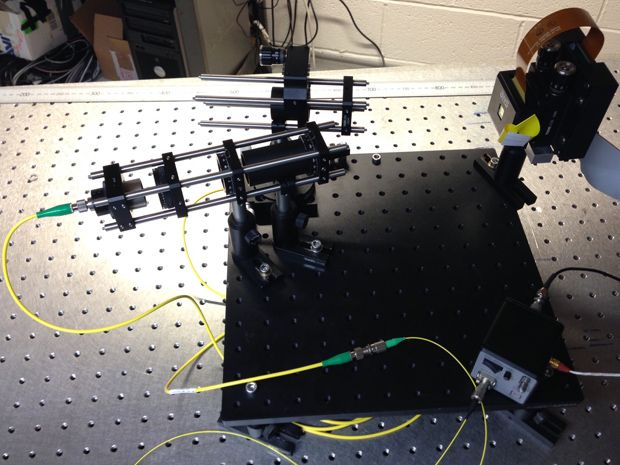
Such indoor optical wireless probably wouldn’t replace Wi-Fi, says Ariel Gomez, a Ph.D. student in photonics at Oxford University who describes the system in IEEE Photonics Technology Letters. But with a potential for data rates of 3 terabits per second and up, it could certainly find its uses. Wi-Fi, by contrast, tops out at about 7 Gb/s. And with light, there’s no worry about sticking to a limited set of radio frequencies. “If you’re in the optical window, you have virtually unlimited bandwidth and unlicensed spectrum,” Gomez says.
To accomplish this, they’d install a base station on the ceiling of a room, which would project the light toward the computer and also receive data heading out from the computer to the Internet.
The trick, of course, is getting the light beam exactly where it needs to go. An optical fiber makes for a target that’s only 8 or 9 micrometers in diameter, after all. The team, which also included researchers from University College, London, accomplished this using so-called holographic beam steering at both the transmitter and receiver ends. These use an array of liquid crystals to create a programmable diffraction grating that reflects the light in the desired direction. The device is similar to that used in projectors, says Dominic O’Brien, a photonics engineer at Oxford who directed the work.
It’s important to use transceivers with a wide field of view to make the alignment task easier, particularly because the device relies on wavelength division multiplexing, which splits the signal into slightly different colors of light. Like a prism, the diffraction grating of the beam steerer bends each wavelength a different amount. With a 60° field of view, the team was able to transmit six different wavelengths, each at 37.4 Gb/s, for an aggregate bandwidth of 224 Gb/s. With a 36° field of view, they managed only three channels, for 112 Gb/s.
The system requires a direct line of sight, and for now the receiver must be in a fixed position. The next step, O’Brien says, is to develop a tracking and location system so that a user could place a laptop at a random spot on a table and have the system find it and create a link.
Brien is a member of the Ultra-Parallel Visible Light Communications project, with colleagues at the Universities of Edinburgh, Strathclyde, St. Andrews, and Cambridge. One of their goals is to develop LiFi, which uses the light that’s also illuminating a room as a way to send data signals. He says LiFi usually refers to schemes based on visible wavelengths of light, whereas this system relies on infrared light at 1550 nm, which is used in telecommunications.
All these technologies—Wi-Fi, LiFi, optical wireless—may wind up being part of how people link devices to the Internet. “The world of communications is a world where everybody always wants more bandwidth,” O’Brien says.
Post a Comment